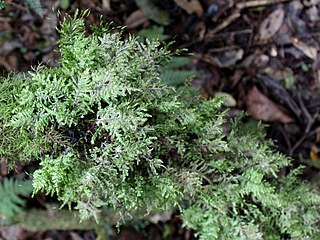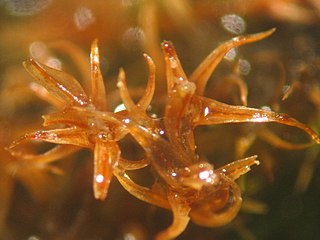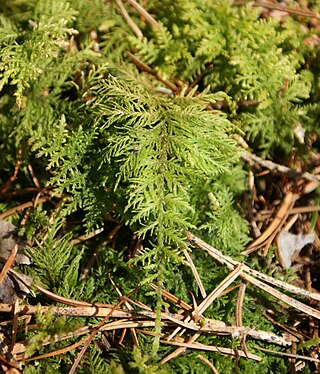Genus is a taxonomic rank used in the biological classification of living and fossil organisms as well as viruses. In the hierarchy of biological classification, genus comes above species and below family. In binomial nomenclature, the genus name forms the first part of the binomial species name for each species within the genus.

Alexander Carl Heinrich Braun was a German botanist from Regensburg, Bavaria. His research centered on the morphology of plants.

Hylocomium splendens, commonly known as glittering woodmoss, splendid feather moss, stairstep moss, and mountain fern moss, is a perennial clonal moss with a widespread distribution in Northern Hemisphere boreal forests. It is commonly found in Europe, Russia, Alaska and Canada, where it is often the most abundant moss species. It also grows in the Arctic tundra and further south at higher elevations in, for example, northern California, western Sichuan, East Africa, Australia, New Zealand and the West Indies. In Scotland it is a characteristic species of the Caledonian Forest. Under the UK's national vegetation classification system, pinewood community W18 is named as "Pinus sylvestris-Hylocomium splendens woodland", indicating its significance in this ecosystem.
Cardiniidae is a family of bivalves in the order Carditida.

The Interim Register of Marine and Nonmarine Genera (IRMNG) is a taxonomic database which attempts to cover published genus names for all domains of life from 1758 in zoology up to the present, arranged in a single, internally consistent taxonomic hierarchy, for the benefit of Biodiversity Informatics initiatives plus general users of biodiversity (taxonomic) information. In addition to containing over 490,000 published genus name instances as at March 2020, the database holds over 1.7 million species names, although this component of the data is not maintained in as current or complete state as the genus-level holdings. IRMNG can be queried online for access to the latest version of the dataset and is also made available as periodic snapshots or data dumps for import/upload into other systems as desired.
Thalassiothrix is a genus of Chromista belonging to the family Thalassionemataceae.

Acrotrichis is a genus of beetles belonging to the family Ptiliidae.

Amblystegium is a genus of moss belonging to the family Amblystegiaceae. The genus was described in 1853 by Wilhelm Philippe Schimper. The genus has cosmopolitan distribution.

Eurhynchium is a genus of mosses belonging to the family Brachytheciaceae.

Dichodontium pellucidum is a species of moss belonging to the family Dicranaceae.

Distichium capillaceum is a species of moss belonging to the family Ditrichaceae.

Plagiothecium is a genus of moss belonging to the family Plagiotheciaceae. It has a cosmopolitan distribution.

Rhynchostegium murale is a species of moss belonging to the family Brachytheciaceae and native to Europe and eastern Asia.
Bryum cyclophyllum, round-leaved bryum, is a species of moss belonging to the family Bryaceae.

Thuidium tamariscinum is a species of moss belonging to the family Thuidiaceae. It has an almost cosmopolitan distribution.

Homalothecium is a genus of mosses belonging to the family Brachytheciaceae.
Arctoa is a genus of mosses belonging to the family Dicranaceae.
Heterocladium is a genus of mosses belonging to the family Thuidiaceae.
Lestonia is a genus of true bugs belonging to the monotypic family Lestoniidae.

Fabroniaceae is a family of mosses belonging to the order Hypnales. It has a worldwide distribution, in temperate and tropical regions.













